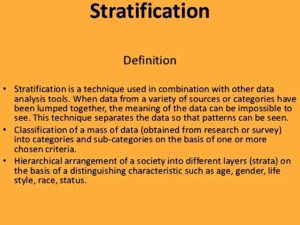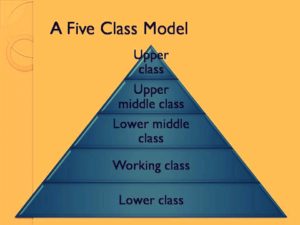Social Stratification: Introduction and Overview
A society where stratification does not exist is a sentence which will always be illogical and untrue. Now the question is what stratification is. A system which has been followed by society from a generation in which there is some kind of classification between people in the name of race, caste, creed etc.

There will be some basis depending on which there can be differences between rights and power between subgroups. You can see from the early times wherein foreign lands, power was in the hand of upper-class people and churches. It was the time when discrimination between people can be seen openly adding to Social Stratification.
In India also, from early times there was a subdivision of society in four groups namely Brahmins, Kshatriyas, Vaishyas, and Shudras. Social Stratification is something which has been visible and emphasized its effects on society.
A society doesn’t need to see stratification based on caste or race. Sometimes this difference of power and rights exist based on sex also. Males and females are given rights differently in a society, which has been discouraged strongly by some of the sociologists like Karlmax and Lalacau. Ogburn and Nimkoff were some of the sociologists who defined Stratification as the process in which people are assigned rights or power in an order from high to low order. Melvin Tumin also agreed to their point of classification done based on power, economic condition, position in society etc.
Another sociologist Lundberg gave a basic definition in which he said Stratification is distinguishing people in the name of power and termed them as two categories via lower and higher.
DETAILS OF HOW SOCIETY IS CLASSIFIED OR STRATIFIED
- Economic condition- There has always been a barrier between rich and poor people. The amount a man earns tells his power in society.
- Social Class- It is a classification which is done both based on economy and caste. It is popularly followed in India.
- Gender– It is a basis of classification from the ancient times were for a long time male society dominated by women.
- Religion- Every man his/her religion, but this is also a basis of stratification for a long time. In India, although it is said that it is a unity in diversity kind of country but on several occasion, people can be seen differentiation other religion openly. For example, the beef ban has become a hot topic because of the religion issue involved.
- Social Network- It is a phenomenon which is generally observed in elite people. They have connections with other high-class people making them the most powerful.
Stratification majorly involves two kind of system in which they take place:-
- Open System
It is a system in which stratification is done based on merit. Achieved status can be linked to this system.
- Closed System
It is a system in which stratification is done based on parental influence, or say the position of parents in the society. This system can be linked with Ascribed status. It is a system which has given power to an individual based on his/her birth.
There are four basic principles of Stratification which can be seen from the early times:-
- Stratification is present and viewed upon the whole community of a society. It does not represent any single individual of a society. In short, it is a mass phenomenon rather than an individual insight. For example in India Hindu religion is not used for a particular individual, instead, it is a collection of so many people altogether.
- Stratification is not a new phenomenon of society. It has been present in our society from a long period, in fact from the time human beings evolution proceeded, its existence has been observed. Only a few changes have been observed but it’s a global phenomenon existing in every part of the world.
- Although Stratification is a global phenomenon, it is a level of effects and happenings in a different place to place.
- Stratification is a combination of beliefs and norms which has occupied people’s mind from generations. The inequality is not anybody’s agenda but having beliefs different from others makes Stratification come into account.
CLASSIFICATION OF MODERN STRATIFICATION

There are three types of classification which is popular and well known by every individual
- Upper Class
They are influential people who have the foremost and most of the powers in their hand. They have well connections in the society which make their work done in the fraction of seconds.
- Middle Class
They are the group of people who neither comes under Upper Class or Poor People. They undergo a set pattern of struggle through their entire life. Neither are they very influential not they are the most deprived people of society. They have to continue their struggle on a medium pace throughout the life. The number of middle-class people is certainly more than upper class or poor people.
- Lower Class or Poor People
They are the people who face poverty. They are deprived of their right of living a wealthy life. They undergo an amount of struggle which other class people cannot go in their own life because they are used to the facilities given.
Stratification phenomenon can be interlinked or understood better by this effect:-
Glass Ceiling – It is the most common thing faced by some minorities of any country or women. They face continuous discrimination providing them unnecessary awkward scenario with depression. This factor was boldly opposed by Conflict Perspective in which Karl Marx stated that this kind of society who does not knows how to provide women same place and respect or regularly practising Capitalism can never improve.
THEORIES OF STRATIFICATION
- KARL MARX
Undoubtedly, Karl Marx was the one who emerged to be emphasizing thinker of all the time. His work gained people attention posts his death i.e. after 1883. He is known as the father of Conflict Perspective in which he was concerned about the peasants and lower-class people conditions. He discouraged the popular concept of Iron Cage. He was always against Social Stratification. He worked efficiently to make people understand what they are lacking due to less knowledge. He emphasized a saying that the difference between the upper class and lower class people. The more upper-class people will keep on earning more and deprived people will keep on decreasing.
He gave a detailing of Capitalist mode in two types:-
- Substructure- The substructure or base is the basis of a working style. The workers and their relation with each other come under substructure. Mainly substructure does not affect Superstructure.
- Superstructure- The superstructure consists of industrialist and owners. Only they can affect substructure by changing any of the norms present in an organization.
2.Max Weber
Max Weber was also majorly involved in Conflict Perspective after Karl Marx. He was impressed by Karl Marx but not every time he agreed with his all theories. He did not believe in the complete removal of Stratification. He wrote three key elements of stratification.
- Class
- Status
- Power
Weber has done an excellent job in research work and classified people in four groups:-
- The Upper Class
- The white-collar workers
- The petite bourgeoisie
- Manual Working Class
After Karl Marx and Weber, another sociologist came into notice and revised their ideas and philosophy regarding Social Stratification.
He agreed with their point that social class depends on the economic condition of a man, but it also depends on political and ethnicity of a group of people too. He classified the group of people in three different types during his time.
- Political Leadership
Political parties have always been a major important role in the decision-making process in society. Hence the leaders of a political party are majorly important in society.
- Military Circle
During the wartime especially at the time of 1950-1960 many decisions were under military heads. They were the biggest decision makers of that time.
- Corporate Elite
The time, at which military leaders got its dominance, same time corporate leaders worked in a parallel way with military leaders to have their place in society.
ANTHROPOLOGICAL THEORIES
Anthropologists were a different kind of people who were not in favour of aspect of Stratification. While other sociologist emphasized that Stratification is a global phenomenon, while anthropologist completely disagreed with their ideation. Recently John Gowdy researched his work in 2006 stating that generally, people are competitive, it’s not about any hierarchical difference between groups. He believed that there could be some places where the concept of egalitarian society i.e. a society in which there could be no stratification, is present. He believed that a society like this existing is not a myth, unlike other sociologists.
Altogether people have many views regarding Stratification. Major people believed that stratification is a global phenomenon.
Practise Question and Answer
Is there any difference between social stratification and social inequality? Examine whether social inequalities can be functional for society?
Social inequality is the unequal distribution of resources like wealth, status, and power. When this inequality applies to a group, and the groups or social categories are ranked in terms of their relative positions on the scale of class, status and power, we get social stratification.
In ancient Indian society, according to Andre Beteillle, the caste system was a system of social stratification and reflected social inequality.
Functional theorists find social inequality as functional because :
(1) It ensures the proper division of labour- else no one will be made.
(2) Parsons sees social inequality as conforming to and evolving from the value consensus in society. Thus, those who perform their roles well get higher prestige and rewards – based on shared values.
(3) Davis and Moore see inequality as necessary for effective role allocation and role performance.
(4) Pareto, Mosca, Michels justify inequality in power by stating the concept of psychological traits of the elite.
(5) Peter Saunders vouches for legal equality and equality of opportunity. However, he says that equality of outcome undermines the other two qualities.
(6) David Marsland sees inequality as a desirable feature as it rewards unequal effort and ability, creating incentives to work harder.
However, others find inequality dysfunctional:
(1) Marx sees inequality as a source of social conflict and social change
(2) MM Iumin sees inequality as perpetuated due to elite self-recruitment and not merit or talent differentials.
(3) CW Mills sees the power elites as perpetuating inequality and as harmful due to unlimited power and unaccountability among them.
(4) Peter Bourdieu states that inequality results in the failure of some groups to accumulate social capital and inability to mobility.
(5) Merton sees inequality as a cause for deviance.
Thus, social inequality may be natural, but once it gets attached to values and ranked into social stratification, it may lead to hostility or social tensions.
Read: Malvin M Tumin views on social stratification
I am Prerna Jha, pursuing mechanical engineering from KIIT, Odisha, But I Love to Read and Write Sociology Related Concepts and Theories. I have done schooling from MVM School, Bilaspur. I have interest in writing love stories or any specific genre. I pursue a great interest in quilting. Right now I am an aspiring writer who writes for various pages. I have participated in many social events. I am a social animal who likes to have maximum participation in any fest.
